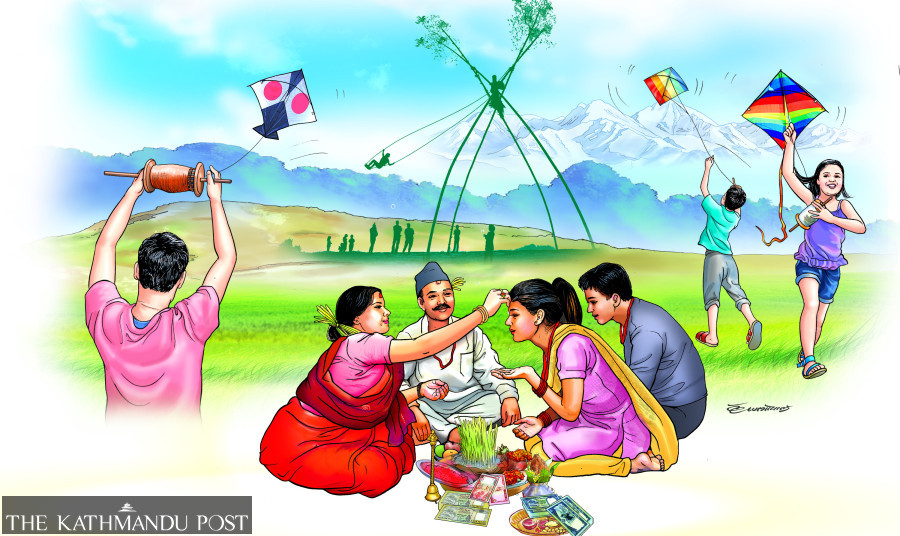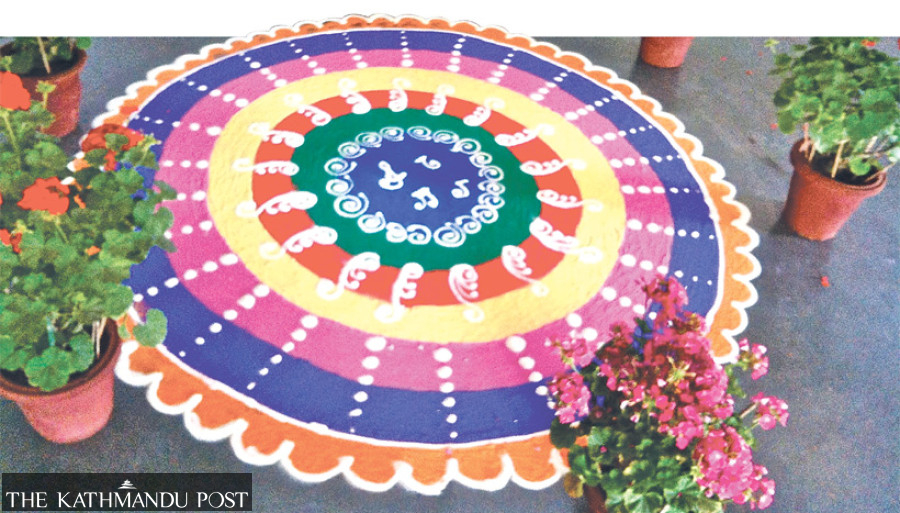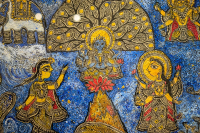Culture & Lifestyle
From tika to Tiktok: Nepali festivals in the digital age
Dashain, Tihar, and other rituals, once full of stories and presence, are now often celebrated through WhatsApp calls, Instagram posts, and viral trends.
Soniva Vaidya
I remember Dashain as a tender embrace. My cousins and I would race barefoot across the terrace, jamara (barley sprouts) tucked behind our ears, tika (red vermilion paste mixed with yoghurt and rice) still damp on our foreheads. Steel plates clinked under the weight of sel roti, stacked like golden memories. The air was thick with marigold and camphor, madal drums pulsing softly in the background. In those sunlit rooms, the family gathered without distraction, fully present, stitched together by ritual and story. My bajai (grandmother) would hum a bhajan in the kitchen and say, “These kids nowadays, what would they know of a Dashain like this?”
She said it with a soft smile, not scornfully but with something like mourning. She already knew we’d grow into a different kind of Dashain, one wrapped in Wi-Fi signals and busy schedules, where a screen’s glow would replace the sunlit kitchen’s warmth.
Now, the air feels quieter. The plates are still full. The rituals still happen. But more often, they unfold behind screens, typically on WhatsApp calls, filtered through Instagram stories, caught between video edits and captions. We say “hello” instead of “namaste” and “thanks” instead of “dhanyabaad.” And somewhere in that shift, the festival’s soul is slipping.
My mother also speaks of a Dashain that stretched across days, a sacred pause when neighbours became family and the night was spent reciting stories passed down through voice and memory, not typed out. Each gesture held meaning. Each offering had a purpose. Even the smallest thing, placing a jamara under a mattress, sweeping the puja (worship) room at dawn, applying tika with both hands, was loaded with history. Today, those same gestures are often performed without question, reduced to a quiet shrug, “This is just what we do.”
For many of us in Gen Z, festivals have become curated performances. We wear the traditional clothes, we light the lamps, we take part in the puja but too often through the lens of a phone. Culture is dressed up for the feed. Aesthetics sometimes eclipse meaning. The perfect photo matters more than the imperfect moment. And in the process, something quieter, something sacred, begins to fade.

Kathmandu itself is changing. Sprawling family courtyards have turned into compact homes. Siblings live across countries. Families are spread thin across time zones. The altar may now be a single candle, lit in between meetings or homework. The spirit of celebration has become a matter of logistics. What was once rooted in sambandha (deep relational ties) can now feel like a checklist: tika, thali, photo, post.
Another example, Tihar, used to arrive gently—flickering diyos (traditional oil lamps), whispered songs, the unspoken warmth between brothers and sisters. It was a festival of light that lived not just in lamps but in shared silence. Now, celebrations often boom from Bluetooth speakers and dance to algorithms. TikTok trends replace traditional songs. The ritual is still there, but sometimes, it feels hollow, almost like a paper version of something once carved in stone.
I watch friends post stunning rangolis and perfectly arranged thalis, and it’s beautiful. But it also feels rehearsed. The whispered instructions of grandparents are replaced with online tutorials. The chants become short audio clips played from someone else’s phone. This is a new way to celebrate, but I constantly wonder: Does it still carry the same weight?
Language is part of this quiet fading. Our mother tongues, like Newa, Maithili, Tamang, and Gurung, among others, carry within them stories, humour, songs, and wisdom. But they, too, are softening, yielding to convenience, to English, to what feels easier. I find myself translating in my head before I speak to elders. And when a language disappears, so does a whole way of understanding the world.
To be clear, this isn’t about resisting change. Culture isn’t something to preserve in glass. It’s alive, which means it adapts, shifts, and evolves. I’m not asking us to put down our phones or cancel our posts. Social media connects us. It lets us share, remember, and create. It brings a global Nepali diaspora together in ways once impossible.
But when it becomes the only lens through which we experience culture, we risk turning festivals into content and content alone.
What I’m asking is this: can we slow down? Can we ask why we do what we do? Can we pause before we post, just long enough to understand? Can we listen to the stories behind the rituals before they slip through the cracks?
Festivals don’t need to be picture-perfect. They must be felt and lived in messy, honest, deeply human ways. Culture doesn’t need to be aesthetic, but it does need to be meaningful.
We don’t need to be perfect keepers of tradition. But we should care more about what our customs mean when no one is watching than how they look when everyone is. Because when rituals lose their roots, they become routines. And when tradition becomes a trend, it no longer grounds us.
Our festivals still breathe. They still carry power. But they ask us to meet them halfway—to be present, to care, to listen, to remember. If we keep culture alive only for the feed, what will remain when the screen fades to black?




 15.69°C Kathmandu
15.69°C Kathmandu















